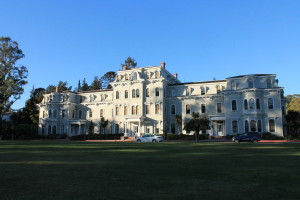
On Oct. 8, the Oakland Museum opened an exhibit to celebrate the 50th anniversary of the founding of the Black Panthers.
The exhibit, called “All Power to the People: Black Panthers at 50,“ includes a large collection of art and historical artifacts relating to the legacy of the Black Panthers. In addition, there are videos and recorded interviews of Black Panther members and people who were influenced by the legacy of the Black Panthers.
As visitors enter the exhibit, they are faced with countless physical representations of the political climate that influenced the establishment of the Black Panthers, many of which are reminiscent of current events related to systemic racism and police brutality. A front page of a newspaper in a glass case reads “Cop Kills Negro Youth; Blood Flows in S.F. Streets.” Beside it, there is a mirror with images of two Black boys and a white police officer crouching down beside them.
The next room strikes the viewer with a full wall display of the first half of the 10 Point System, a list of demands drafted by Black Panther founders Huey P. Newton and Bobby Seale. The list, titled “What We Want,” demanded basic human rights for the Black community, such as decent housing, full employment and education, as well as “the power to determine the destiny” of the Black community.
Within the same room is a timeline of the events that occurred during the first two years of the Black Panthers’ founding. By the end of the timeline, there is an original copy of the other half of the 10 Point System, a list of ten statements titled “What We Believe.”
After entering the room filled with the background history that motivated the formation of the Black Panthers, the exhibit presents visitors with other art and memorabilia, such as paper bags from their Free Breakfast program, photographs of the Black Panthers, a rifle that was once confiscated by the police and video projects of interviews with former Black Panthers and those influenced by the group.
The people who visited the exhibit come from all walks of life. Some lived through the time of the Black Panthers, are activists themselves, learned about the party in school or were simply interested in the history. Beki McElvain, a Mills alumna who also wrote her thesis on the cultural arts district in graduate school, came to the exhibit with her friends and learn the history of the Black Panthers.

“I’m in there with friends of color[…]and I know they are receiving the exhibit very differently than I do. As a cis white woman, even though I’m queer, I’m not experiencing the same level of oppression,” McElvain said.
Denmark Ves, an activist, expressed an interest in the photographs of young people, white people and Asian Americans in the Black Panther Party, as this is a part of Black Panther history rarely discussed in media.
“The photos of the young people that were Panthers. The average age being 19, and we see the photos of the 19-year-old Panthers,” Ves said.
Jim Richardson, who grew up in LA watching the Black Panthers on the news, says this exhibit was just looking back in the past. Richardson said that when he sees that the issues the Black Panthers were combating resurfacing, a censorship of these injustices is sure to follow.
“I think it will happen again…Put it on the radio so more people [will] know,” Richardson said.
Richardson wishes that people knew more about the Black Panthers, and that their history is not as violent as it is often portrayed.
“All Power to the People: Black Panthers at 50” seeks to rewrite negative narratives about the Black Panther Party by highlighting their rich history and importance in Oakland and beyond. The exhibit is open from now until Feb. 12, 2017.



